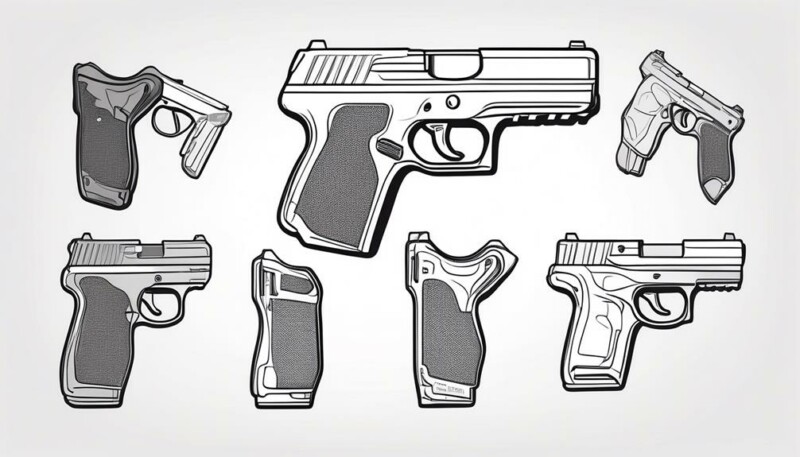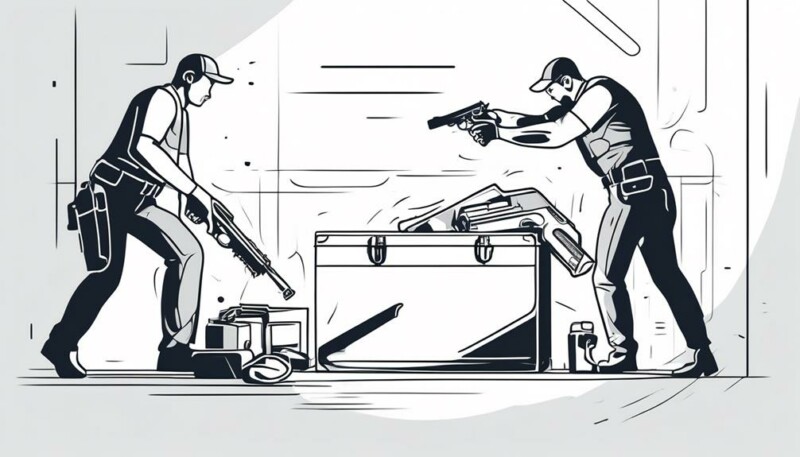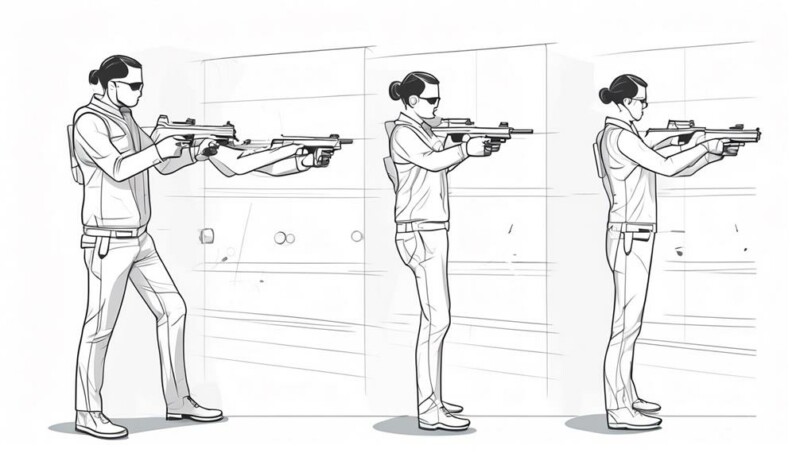Navigating the sea of concealed carry can feel like a daunting voyage, but once you've mastered the key terms, you'll find yourself steering the ship with confidence.
You'll need to understand terms like 'dry fire practice,' 'holster safety,' and 'pistol marksmanship,' among others. These aren't just fancy lingo; they're crucial skills and knowledge areas that you need to master for secure concealed carry.
Each term paints a piece of the larger picture, from the fundamentals of firearm safety to advanced techniques for effective self-defense.
Stick around and you'll soon see how these key terms translate into practical skills, ensuring your concealed carry journey sails smoothly into the horizon.
Key Takeaways
- Understanding and following the four critical safety rules coined by Jeff Cooper is essential for secure concealed carry mastery.
- Equipping oneself with quality concealed carry equipment, such as a reliable holster, proper ammunition, a sturdy belt, concealed carry clothing, and a cleaning kit, is crucial for safe and responsible firearm ownership.
- Mastering concealed carry techniques, including proper sight picture, sight alignment, smooth trigger pull, and efficient magazine release, through regular practice drills is necessary for skill enhancement.
- Familiarizing oneself with the legal aspects of concealed carry, including state laws, responsibilities as a gun owner, self-defense laws, obtaining a concealed carry permit, and staying updated on changes in the law, is vital for compliance and responsible gun ownership.
Understanding Firearm Terminology

To safely and effectively use firearms, you need to thoroughly understand firearm terminology, starting with the four critical safety rules coined by Jeff Cooper. As a concealed carrier, these rules are your foundation.
First, always treat a gun as if it's loaded—even an unloaded gun can still cause harm if improperly handled.
Second, never let the muzzle cover anything you aren't willing to destroy. This is firearm safety always, ensuring your concealed carry firearms won't accidentally harm anyone.
Third, keep your finger off the trigger until your sights are on the target. This rule emphasizes the importance of safe shooting habits.
Fourth, be sure of your target and what's beyond it. When you carry, your carry holster isn't just a convenience—it's a responsibility.
Understanding these safety rules, as well as other terms like 'reloading', 'firing techniques', and 'drawing', can significantly enhance your gun safety skills. This knowledge is also critical for responsible firearm maintenance.
Master these key terms and concepts, and you'll be well on your way to becoming a more confident, responsible, and effective concealed carrier.
Essential Concealed Carry Equipment
Equipping yourself with the right gear is just as crucial as mastering the basics of firearm usage when it comes to effective concealed carry. Your essential concealed carry equipment shouldn't only aid in keeping your firearm concealed but also ensure you're ready to fire when the trigger is pulled.
You need to be proficient in handling firearms, from how to always keep your finger pointed in a safe direction to knowing how to draw your firearm smoothly. Let's look at some vital gear:
- A quality holster: This keeps your gun secure and accessible. It should be comfortable and custom-fitted to your firearm.
- Proper ammunition: Not all ammo is created equal. Use the type your firearms training recommends.
- A sturdy belt: This provides the necessary support for your holster.
- Concealed carry clothing: Clothes designed for concealed carry have hidden pockets to keep your gun out of sight.
- A cleaning kit: Regular maintenance keeps your gun in a safe direction, ready when you need it.
Safe Handling of Firearms

Having equipped yourself with the necessary gear, it's equally vital to know how to handle your firearm safely, not just for your protection but for those around you as well. The first step towards secure concealed carry mastery is understanding the basic rules of safe handling of firearms.
Always keep your finger off the trigger until you're ready to shoot. Ensure the firearm is unloaded when not in use, and always visually inspect the chamber even if you believe it's empty. Remember, a loaded firearm is a potential hazard if mishandled.
It's crucial to maintain a good grip on your firearm. Your dominant hand should hold the gun while your non-dominant hand supports it. Ensure the muzzle is pointing in a safe direction at all times.
Here are some basic guidelines in table form:
| Rule | Description | Importance |
|---|---|---|
| Finger Off The Trigger | Don't touch the trigger until ready to shoot | Prevents accidental discharge |
| Inspect The Chamber | Always check if the firearm is loaded | Avoids unintentional shooting |
| Good Grip | Hold the firearm firmly with both hands | Provides control and accuracy |
| Muzzle Direction | Always point the muzzle in a safe direction | Prevents injury in case of accidental discharge |
Mastery of Concealed Carry Techniques
So, you want to master concealed carry techniques? It's not just about having a firearm; it's about knowing how to use it safely and effectively. Here's what you need to know:
- Proper sight picture: This is achieved by aligning the front sight within the rear sight and placing them on the target.
- Sight alignment: Maintain the alignment of the front sight and rear sight, ensuring your rounds hit the target.
- Trigger pull: It's crucial to pull the trigger smoothly and directly, without moving the firearm off target.
- Magazine release: You need to master releasing and replacing the magazine quickly and smoothly, without looking.
- Shooting drills: Regular practice, such as the El Presidente Drill, helps reinforce your skills and ensures you can put rounds on target under pressure.
Practice Drills for Skill Enhancement

When it comes to elevating your concealed carry skills, incorporating regular practice drills can significantly enhance your proficiency and bolster your confidence. The first thing you need to do is make sure your firearm is clean and ready for use. Dry firing, where you pull the trigger without a round in the chamber, is a cost-effective way to practice.
Start with slow, deliberate actions. Practice slow, make each movement count. Getting ready this way helps build muscle memory. When you're comfortable, try incorporating one round, then three rounds.
Focus on your trigger control – the aim is to pull the trigger smoothly and steadily, ensuring your shots fired are accurate. Practice this with dry firing first, then move on to live rounds.
Remember, speed isn't the initial goal. Accuracy is. Only when you're consistently hitting your target should you start to speed up.
Lastly, practice drawing your firearm from its concealed location. This is vital as in a real-life situation you won't have the luxury of time. Remember, practice makes perfect. Keep refining your skills, and your concealed carry mastery will continue to grow.
Legal Aspects of Concealed Carry
You need to fully grasp your state's concealed carry laws to stay on the right side of the law. It's essential to understand your responsibilities as a gun owner, including the legalities of using force and the specifics of self-defense laws in your area.
Stay informed about the process of obtaining a concealed carry permit, and maintain knowledge of any changes in the law to ensure you're always in compliance.
Understanding Concealed Carry Laws
Navigating the complex world of concealed carry laws is crucial if you're planning to legally carry a firearm in public spaces, as these laws not only vary by state but also dictate where you can carry, the necessary permits, and the legal definitions of self-defense.
To develop secure concealed carry mastery, you need a clear understanding of key terms and laws. Here's what you should consider:
- Always be sure of your target and what the gun is pointing at before pulling the trigger until you're ready.
- Be aware of where the front of the barrel, or muzzle is pointing during the firing process.
- Understand the mechanism of slide back when it comes to shooting.
Remain updated on where and when carrying is legally permitted. Regularly consult legal resources to understand changes in the laws.
Responsibilities of Gun Owners
Building upon your understanding of concealed carry laws, it's equally critical to comprehend your legal responsibilities as gun owners, particularly when it comes to the various aspects of concealed carry. As a crucial key term for secure concealed carry mastery, you must grasp the wide variety of legal implications, from where your muzzle is pointing to how your finger rests in front of the trigger.
Stance, whether it's called a Weaver or an isosceles, can also have legal implications when shooting with one. The second most important responsibility is understanding deadly force and 'reasonable force'. You stand directly behind your actions, so always remember these responsibilities of gun owners.
This mastery not only ensures your safety but also keeps you within the bounds of law.
Concealed Carry Permit Processes
Understanding the concealed carry permit process in your respective state is a crucial step towards mastering the art of legally carrying concealed firearms. It's one of the key terms for secure concealed carry mastery. It may seem daunting at first, but that's okay.
Here's a breakdown of the concealed carry permit processes:
- Research your state's application process, eligibility, and documents needed.
- Complete required training and safety courses. Practice different techniques including 'Fire Two' where the muzzle is pointing at close quarters.
- Submit your application, pay fees, and undergo a background check.
- Learn about your state's laws and regulations, including prohibited locations.
- After approval, responsibly maintain your permit, staying updated on law changes.
The first two steps require a considerable amount of effort, but they'll get you ready for the real world of concealed carry.
Frequently Asked Questions
What Is the Term for Concealed Carry?
The term for concealed carry refers to the practice of discreetly carrying a firearm on your person, usually for self-defense. It's essential you're well-versed in the laws and regulations, have proper training, and often, a specific permit is required.
What Are the 4 Basic Rules of Gun Safety?
You're asking about the 4 basic rules of gun safety. Here they are:
- Treat every gun as if it's loaded.
- Never point at anything you don't want to destroy.
- Keep your finger off the trigger until you're ready to shoot.
- Be aware of your target and what's beyond it.
These rules are fundamental to safe firearm handling and are crucial to remember and apply, ensuring your safety and those around you.
What Are the Golden Rules of Gun Safety?
The golden rules of gun safety are essential for any firearm owner.
You've got to always treat your gun as if it's loaded.
Never point it at anything you don't intend to destroy.
Keep your finger off the trigger until you're ready to shoot.
Lastly, be sure of your target and what's beyond it.
Adhering to these rules can prevent accidents and ensure you're responsibly handling your firearm.
What Is the 4 O'clock Position for Concealed Carry?
The 4 o'clock position for concealed carry is a term you mightn't be familiar with. It's a reference to the position on your body where you're carrying your concealed weapon.
Imagine your waist as a clock face; your belly button is at 12 o'clock. Now, move around to 4 o'clock, it's just behind your hip. That's the 4 o'clock position.
It's a popular spot because it's comfortable and offers easy access to your weapon.
Conclusion
In a nutshell, mastering concealed carry is like learning a complex dance. It involves knowing the steps, or in this case, the safety rules, equipment, and techniques.
Regular practice drills polish your skills, while understanding the legal aspects keeps you on the right side of the law.
So, don't just carry, carry with mastery. Because when it comes to self-defense, knowledge isn't just power, it's survival.
